SDG&E Employee Fired Over Alleged White Supremacist Hand Sign is a Latino

An employee of the local utility company was fired last year after a picture posted on social media showed him making a common hand sign that has more recently become associated with white supremacists, but there is no evidence he had any racist intentions or even knew what the hand sign meant at the time.
Emmanuel Cafferty, 48, is now out of a job, prospective employers steer away from hiring him, and he’s about to lose his apartment over one snapshot in time that led people to presume he is a white supremacist.
It seems like unfortunate situation, especially for a Latino.
ONE FATEFUL DAY
Cafferty was driving a San Diego Gas & Electric work truck on June 3, 2020, when a car drove up to the left of him and the driver held out his cell phone apparently to take a picture of Cafferty.
“The driver was yelling at me, saying ‘Do it again’ and he was flashing the OK sign with his hand,” Cafferty told La Prensa San Diego during an extensive sit-down interview. “I didn’t understand what he meant, then he drove away,” he added.
Cafferty was in Poway and had just finished his last site visit of the day as an underground utility detection technician for the energy company. He had already responded to a service request at Poway High School then stopped by the last job of the day nearby before ending his shift at 3:30 p.m.
“I started the day with a site in Borrego, then ended up in Poway for two site visits before cutoff time,” Cafferty said. “There was a heat wave that hit 109 degrees in Borrego and I had run out of water to drink by the time I got back to Poway, so I headed to the Carl’s Jr for a cold drink.”
Cafferty drove toward the nearest fast food restaurant at Pomerado and Twin Peaks Roads, but saw a protest march crowding around the restaurant.
The protest was a Black Lives Matter march organized by Poway students in response to George Floyd’s death just one week earlier.
Cafferty says he didn’t want to get stuck in the crowded parking lot, so he parked in another area of the shopping center to fill out his work report for the day.
“It was at the height of the pandemic and I thought that going to a drive-thru was the easiest way to get a drink, but the protesters were all around the restaurant, so I parked by the grocery store to fill out my report,” Cafferty said.
The shopping center is just 0.7 miles from his last customer job, and is on Twin Peaks Road which Cafferty uses to drive home to Ramona.
After he finished his report, Cafferty left the shopping center and drove East on Twin Peaks Road toward his home in Ramona when the brief encounter with the other driver occurred about 1.4 miles from the shopping center.
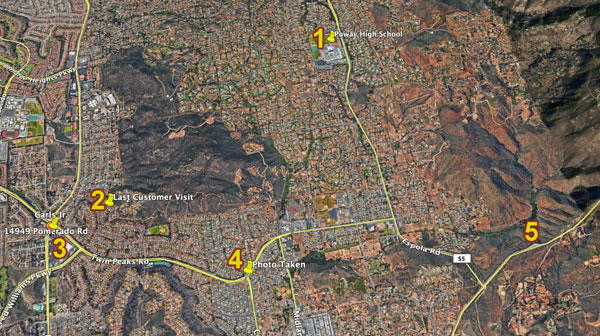
Cafferty continued home and thought nothing more about the incident until his supervisor called him a few hours later.
“My supervisor called and said my picture was all over Twitter and that he had to come to my house because I was being suspended,” Cafferty said. “He and another employee came to my house and took my work truck, work keys, ID card, and equipment,” Cafferty added.
That’s when Cafferty was told that a picture of him making a hand gesture used by white supremacy groups and agitators was posted on Twitter.
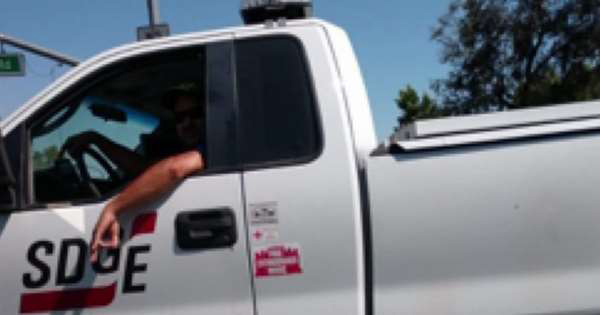
OK OR NOT OK
The picture of Cafferty shows him with his left arm hanging down from the truck’s driver window with his thumb and a finger together to form a circle, and the other fingers straight.
The hand sign, traditionally used to signify “OK”, is used in sports, casual conversations, and even by some of the biggest stars and politicians of our time.

But, in recent years, political agitators and white supremacist have used the gesture to depict the letters W and P, for white power.
The Southern Poverty Law Center and the Anti-Defamation League describe the gesture as being used by white supremacy groups, but also by conservatives who have used it to troll – or upset and agitate – liberals who they believe will overreact to the hand sign.
The Southern Poverty Law Center, a leading civil rights and anti-discrimination non-profit group, says the “social-media-driven controversy over the meaning of the well-known hand sign has arisen in part as the result of a deliberate hoax concocted on the Internet message board known as 4chan.
Some white nationalist and race hate groups, including the Proud Boys and Patriot Prayer supporters, have used th gesture to deliberately provoke racial tensions.
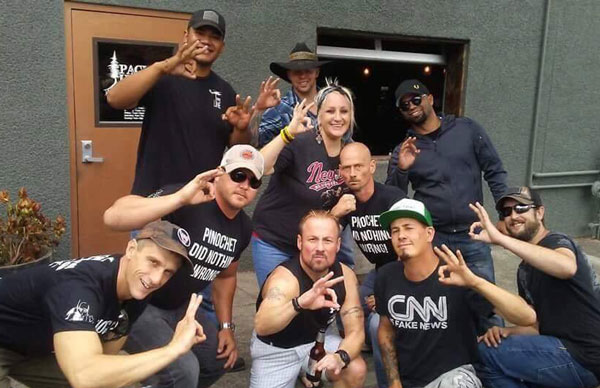
The Anti-Defamation League website cautions against assuming that use of the gesture alone is a sign of trolling or racism.
“The overwhelming usage of the ‘okay’ hand gesture today is still its traditional purpose as a gesture signifying assent or approval. As a result, someone who uses the symbol cannot be assumed to be using the symbol in either a trolling or, especially, white supremacist context unless other contextual evidence exists to support the contention. Since 2017, many people have been falsely accused of being racist or white supremacist for using the ‘okay’ gesture in its traditional and innocuous sense.”
Cafferty maintains that, not only had he not known the hand gesture was used in a racist way, but that he wasn’t consciously making a hand gesture in the first place. He maintains he was cracking his knuckles, a habit he has had for years where he flexes each finger with his thumb.
The driver of the other car posted the picture on Twitter and others quickly reposted the image and expanded its exposure.
Within days, dozens of comments had been posted online, with many saying that the sign is not racist and others cautioning SDG&E against firing him for such an innocuous gesture.
But, just five days after the incident, however, Cafferty was fired.
FROM BEST JOB TO NO JOB
Cafferty had only been employed by SDG&E for about six months and was still within the one-year probationary period where an employer can fire a new worker for any reason, or no reason at all.
Before being hired at SDG&E, Cafferty had worked for over four years for UtiliQuest, a local subcontractor used by SDG&E to locate and mark underground utility lines and pipes before someone begins construction or digging. Cafferty knew that SDG&E was beginning to directly hire technicians from the subcontractor company, and he applied during the first round of hiring.
Cafferty has one of the first eight subcontractors hired directly into SDG&E, and the new job was the best job he’d ever had. His pay nearly doubled and it was the first time he had good health insurance for himself and his daughter, enrollment in a pension plan, and what he believed was long-term job security.
“I’ve had some tough times in my life, and the job at SDG&E was the first time I felt secure in providing for myself and my daughter, and even my parents felt that they didn’t have to worry about me anymore,” Cafferty said during the interview.
The job was a life-changer, but little did know how much it would truly change his life.
Cafferty grew up in Lincoln Acres, a community East of National City that was predominantly Latino when Cafferty was growing up.
Officially an unincorporated section under county control, Lincoln Acres was first settled by farmers during the Great Depression in the 1930s and still allows residents to keep farm animals. One of the street in Lincoln Acres is Lanoitan Ave, or National spelt backwards, an ironical reference to its seemingly backward style compared the neighboring National City and Paradise Hills.
Cafferty, whose Mom is a Spanish-speaking Latina raised in Logan Heights and Dad is Latino and Irish who grew up in Shelltown, was raised in a largely Latino culture. Before high school, Cafferty and his family moved to Ramona where he and his parents still live.
“I grew up as a Mexican-American in a Latino neighborhood, and my family is mostly Latinos,” Cafferty said. “If I was a racist, I would literally have to hate 75% of myself,” he added.
CAUGHT IN THE CANCEL CULTURE WARS
The modern phenomenon of calling out people for insensitive comments, offensive actions toward others, and even celebrities doing blackface skits or White actors portraying characters of color has become known as cancel culture.
Boycotts and protests have become commonplace when someone transgresses the acceptable boundaries of today’s societal heightened sensitivities of politics, race, gender, or other personal attributes.
Companies have lost sales, networks have lost advertisers, and shows have lost stars over such offenses, and no one should believe themselves to be above being called out for inappropriate behavior at a time when racial justice and criminal justice reform in the wake of unarmed people being killed by police and subsequent protests and riots have shaken our communities.
But “cancel culture” is usually a reaction to transgressions among the professional class with clout -politicians, business leaders, famous people, Hollywood stars- and for actions that offend, marginalize, or assault minorities, women, or other affected group or individual.
US Senator Al Franken resigned in 2017 after allegations of assaulting women, last year Jimmy Fallon was grilled for a skit he did 20 years ago wearing blackface to impersonate Chris Rock, and Ellen DeGeneres has seen her audience shrink after stories broke that she creates a toxic environment behind the scenes of her seemingly light-hearted show. All three apologized and have moved on with their lives and careers, albeit changed.
When a professional CEO, an actor, or even a politician is “cancelled” for cause, they usually have the ways and means to rebuild their careers, replace their losses, or even simply retire and disappear. Their abilities are unique and marketable in other ways, and their stature in society is powerful enough to withstand the cancellation.
In the case of Cafferty, however, he is a working class single father who did not utter a bad word, assault any person, or engage in regrettable behavior. His actions were misinterpreted by a passing driver, and catapulted into the social media universe through no fault of his own and with virtually no way to defend himself in any meaningful way.
And he now been deprived of his ability to work and provide for himself and his family, and has been branded a racist by his former employers and on social media.
Cafferty explains that he has a habit of cracking his knuckles by pulling each finger with his thumb, and even some of his friends and family admit they have often seen him exercising his fingers, even on both hands. Not a racist gesture, but a personal habit with no negative intent.
The online medical resource, WebMD, has a slideshow dedicated to “10 Ways to Exercise Hands and Fingers”, with one slide explaining the “Thumb Touch” by touching “your thumb to each of your four fingertips, one at a time, making the shape of an O.”

And the CORE Institute, an orthopedic care provider in Arizona that provides patient care “through a commitment to excellence, innovation and learning”, developed a series of hand exercises for patients to “help increase the strength of the muscles and the range of motion of the joints” in their hands. Among the exercise is the “Thumb to Finger Opposition”.

The Internet shows more examples of innocuous uses of the hand gesture than offensive ones, lending credence to Cafferty’s explanation that the picture of him was grossly misinterpreted as something more likely to be benign than malicious.
TODAY AND AN UNCERTAIN FUTURE
Now, after more than 9 months since the incident, Cafferty is still unemployed and still hoping the whole situation will somehow be resolved.
“All I want is my job back, my life back,” Cafferty said. “They took my livelihood away, and painted me as a racist that won’t go away,” he added.
A quick search on GOOGLE returns dozens news articles and references to the incident, along with multiple links to the now-infamous picture.
Articles in the Atlantic, The Hill, and other outlets have detailed Cafferty’s story, and he was recently interviewed for an upcoming HBO documentary about race relations. He is also scheduled to fly to Miami later this month to be interviewed for a National Geographic documentary in the works.
The San Diego Reader ran a cover story on Cafferty in November 2020 with the headline, “Emmanuel Cafferty is not a white supremacist”, yet the perception still haunts him every day.
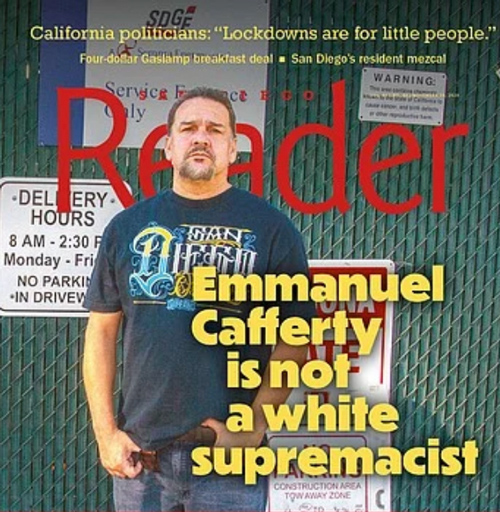
Bill Maher mentioned Cafferty during the February 26th episode of his popular HBO political comedy show. Maher was talking about the “cancel culture” when he warned that anyone can fall victim to overreaction of political correctness, not just celebrities.
“Take Mr. Emmanuel Cafferty, he is, was, a San Diego Gas & Electric worker, but he got fired because someone reported him making a white supremacist hand gesture outside the window of his truck,” Maher commented while showing the now-infamous picture of Cafferty. “But he’s not a white supremacist, he’s Latino, and he wasn’t making a hand gesture, he was probably just flicking a booger,” Maher joked.
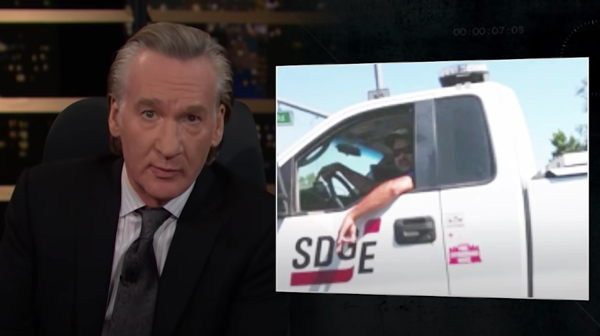
Cafferty has filed an Equal Employment Opportunity Commission (EEOC) complaint against SDG&E, and is preparing a lawsuit to challenge his wrongful termination and also claims of defamation of character for the stigma this situation has placed on his reputation.
“I want to be put back to where I was before that horrible day that changed my life,” Chafferty said. “My whole world was turned upside down and I don’t think I deserved it over nothing more than a picture of me cracking my knuckles while driving,” he added.
SDG&E STANDS BY FIRING, BUT REFUSES TO GIVE DETAILS
The shock of losing his job so abruptly, and over one picture on social media, still haunts him today.
Cafferty maintains that SDG&E never confronted him with their evidence about the incident, or questioned any of his friends or relatives to find out if there was any evidence of a racist intent or other instances of racist expressions. He was only told that his story “had too many holes” and he was being terminated.
“They didn’t come and look in my house or ask my family if this was something they thought I would really do, so they just acted on the one picture that was totally meaningless, totally out of context,” Caffery said. “There isn’t one shred of evidence that I ever did anything like this anywhere else at any time in my life.”
The man who took the picture and posted it on Twitter told NBC News after the incident that he may have gotten “spun up” about the interaction with Cafferty and misinterpreted the hand gesture. The poster said he never intended for Cafferty to lose his job, and later deleted his Twitter account, but not before the damage had been done.
SDG&E reacted within hours to the online picture and said it had already “launched an investigation into this report” and that the company stands “united with those in our community fighting against racial inequity.”

But others posted messages of support for Cafferty, including the mother of his daughter, who clarified that he cracks “his knuckles when he’s nervous.”

La Prensa San Diego reached out to SDG&E for comment on Cafferty’s firing. The energy company responded with a statement that it stands by its “decision to ultimately terminate Mr. Cafferty’s employment after a careful and good faith investigation.”
SDG&E has provided other media outlets with similar comments generally defending Cafferty’s firing.
When La Prensa San Diego asked SDG&E clarifying questions about the allegations in the comment and for details of the findings of its investigation, the spokesperson added that “we have nothing to add to our statement.”
La Prensa San Diego chose not to included SDG&E accusations without additional clarification and details to support their statement.
An online petition asking SDG&E to reinstate him has reached nearly 10,000 signatures, yet the company refuses to review his case.
CAFFERTY’S BATTLES FOR HIS JOB WHILE SDG&E BATTLES TO KEEP ITS OWN
The case comes at a bad time for San Diego Gas & Electric as it is currently fighting to keep its franchise agreement with the City of San Diego that allows it to deliver power within the City.
SDG&E has an existing 50-year franchise that expired in January but has been extended until June while the City Council considers what to do going forward. SDG&E was first granted a 50-year franchise in 1920 and renewed in 1970.
The City opened the franchise renewal for bids last year, but only SDG&E responded. The Council has now extended the bidding process in hopes that other companies will bid to take over the delivery of power in the City.
SDG&E’s bid was a 20-year renewal wherein the company would pay the City an $80 million fee up-front, and continue annual payments which have totaled nearly $64 million last year alone, in addition to a total of nearly $64 million in customer surcharges dedicated to the City’s utility undergrounding program.
City leaders have indicated that they prefer to only offer either SDG&E or another company a short term agreement, between 5 to 10 years, to give the City time to explore and plan for a potentially different long-term arrangement that will take into account new and emerging energy technologies and business models.
One of the future possibilities is a City-run public utility agency owned by taxpayers, like the Los Angeles Department of Water and Power, and Sacramento Municipal Utility District.
The San Diego City Council is expected to make a decision on the franchise agreement next month.
In the meantime, Cafferty says he will continue to work toward putting his life back together.
“I know I didn’t do anything wrong and I hope SDG&E will see that too,” Cafferty said. “All I ever wanted was to do my job in the best way I could and go home every day with the pride of knowing I did my job well,” he added.
Cafferty’s family created a GoFundMe campaign to help him pay for his legal costs.


 Arturo Castañares
Arturo Castañares




